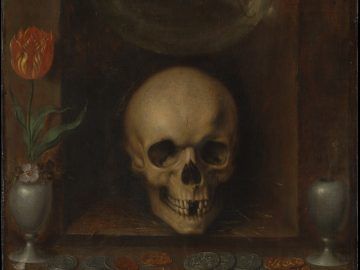Lynn Casteel Harper at the Paris Review:
 The skull in Vanitas Still Life, while undoubtedly grim, bears a wry, gapped grin—a grin missing four front teeth. Stripped of its flesh, our bone structure apparently discloses a faint, effortless smile. The skull’s stark, denuded presence signals gravity, but its blithe affect signals buoyancy. Perhaps this face of death reflects both the weeping Heraclitus and the laughing Democritus, pointing viewers back to Ecclesiastes: there is “a time to weep and a time to laugh.” Wisdom here comes lodged in apposition—pairs of apparent opposites, united by the word and: “a time to be born, and a time to die … a time to break down, and a time to build up … a time to cast away stones, and a time to gather stones together.” These lines in Ecclesiastes encourage readers to imagine a world in which the poles of existence create vibrant tension, in which life and death, gathering and releasing, embracing and refraining, weeping and laughing, do not negate each other but instead balance and enrich. There is aggregation and integration—even with loss, even in death.
The skull in Vanitas Still Life, while undoubtedly grim, bears a wry, gapped grin—a grin missing four front teeth. Stripped of its flesh, our bone structure apparently discloses a faint, effortless smile. The skull’s stark, denuded presence signals gravity, but its blithe affect signals buoyancy. Perhaps this face of death reflects both the weeping Heraclitus and the laughing Democritus, pointing viewers back to Ecclesiastes: there is “a time to weep and a time to laugh.” Wisdom here comes lodged in apposition—pairs of apparent opposites, united by the word and: “a time to be born, and a time to die … a time to break down, and a time to build up … a time to cast away stones, and a time to gather stones together.” These lines in Ecclesiastes encourage readers to imagine a world in which the poles of existence create vibrant tension, in which life and death, gathering and releasing, embracing and refraining, weeping and laughing, do not negate each other but instead balance and enrich. There is aggregation and integration—even with loss, even in death.
more here.
